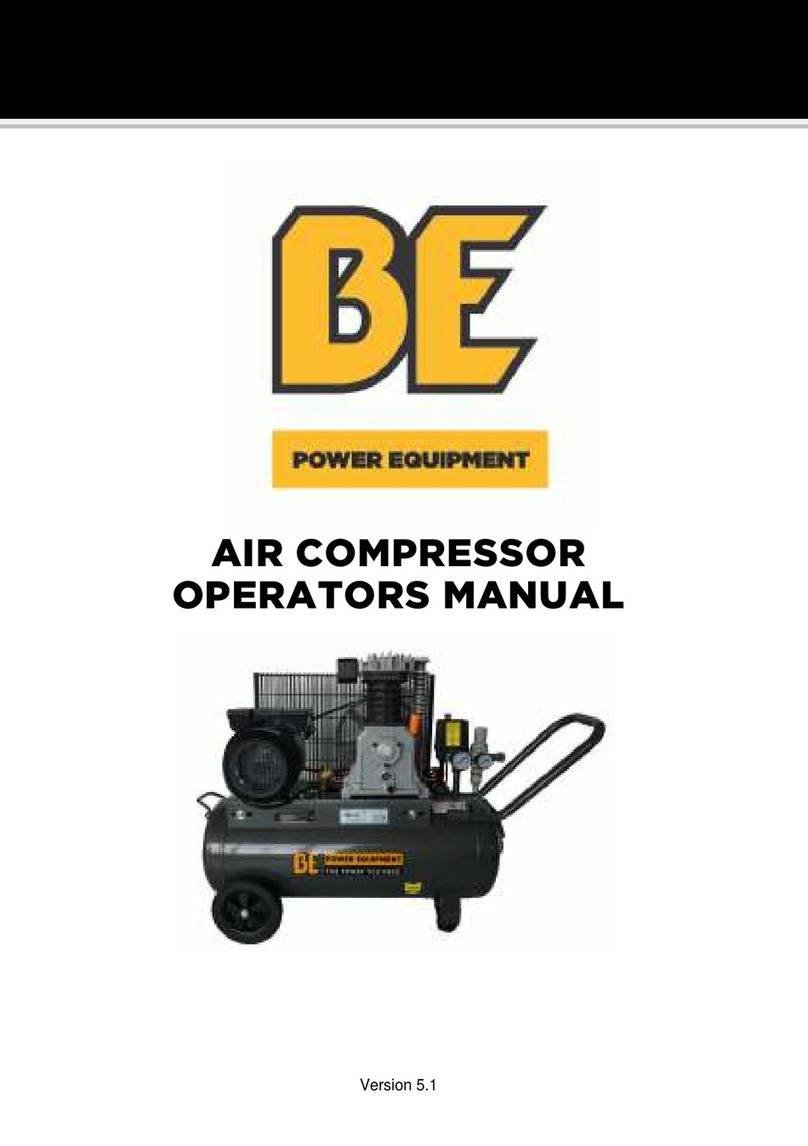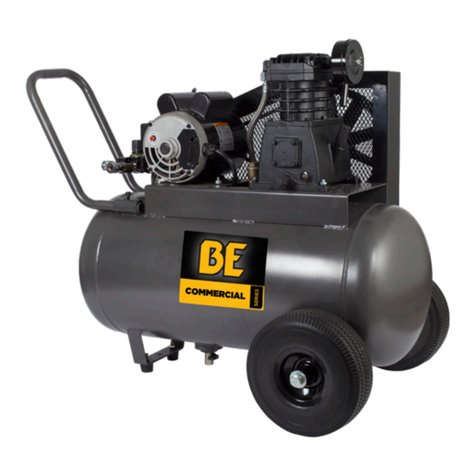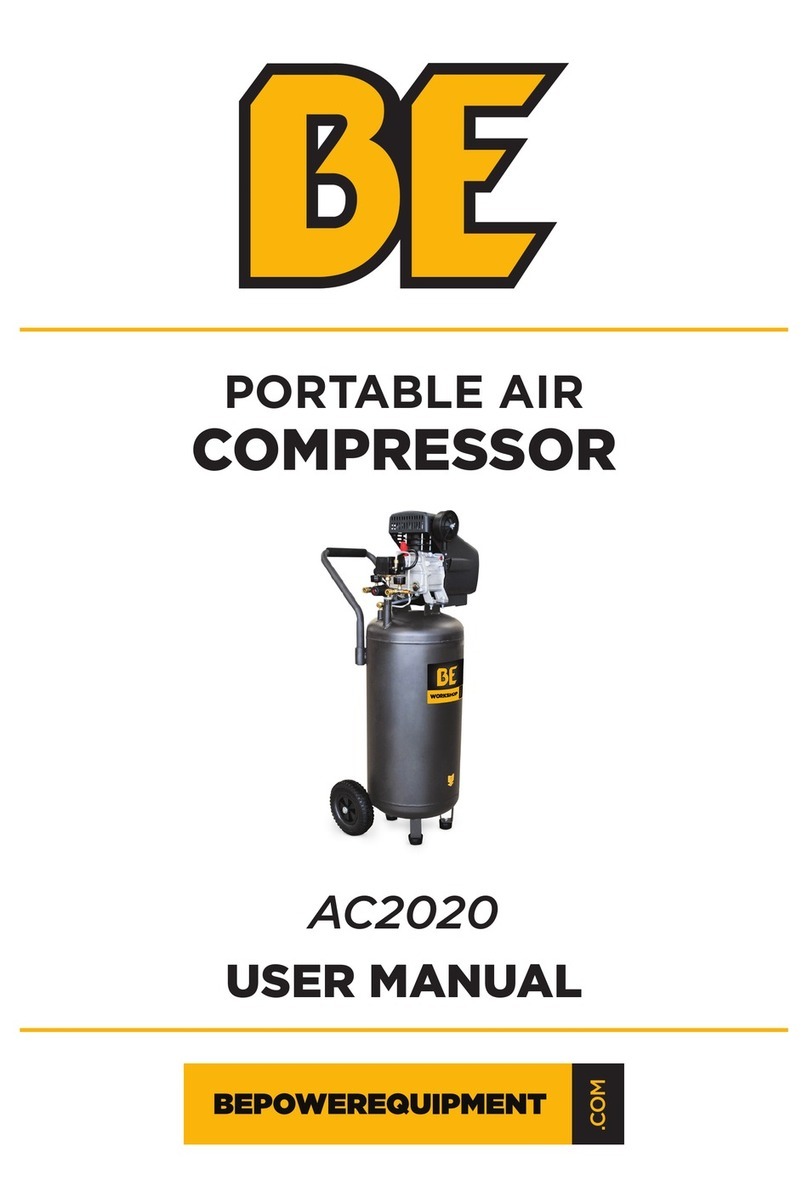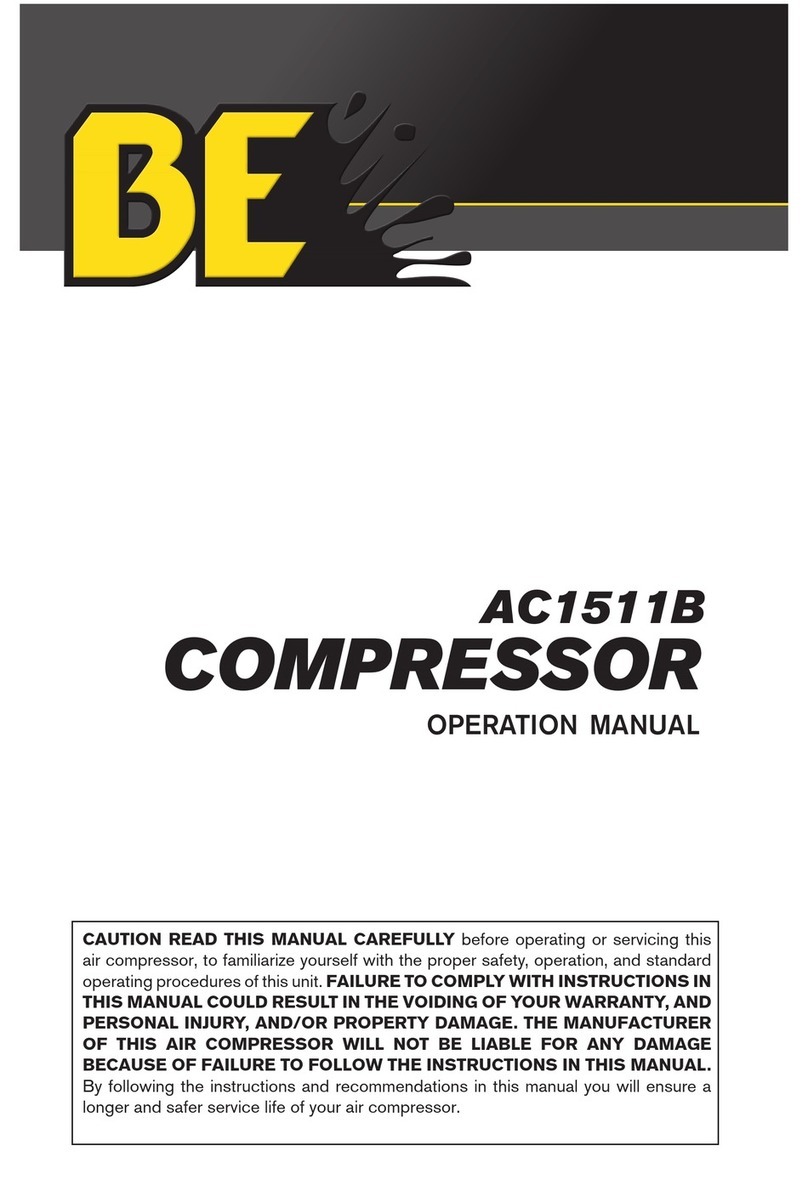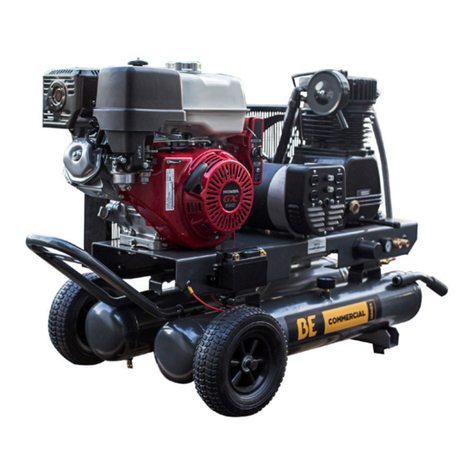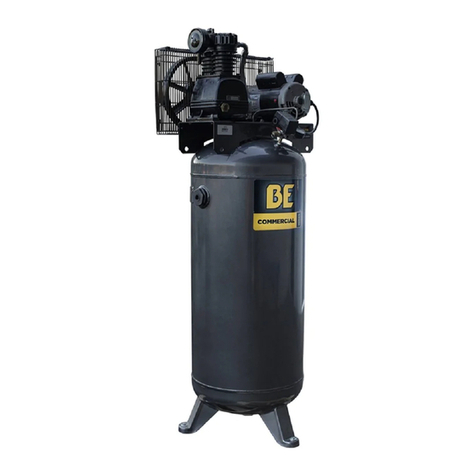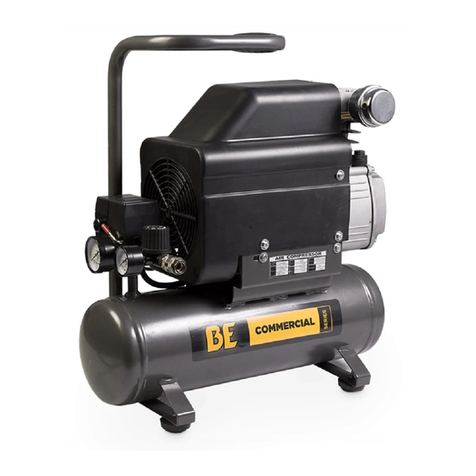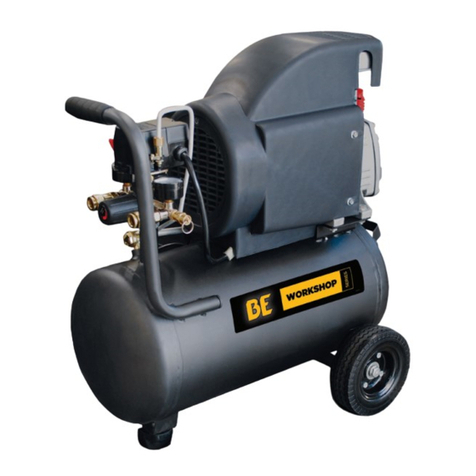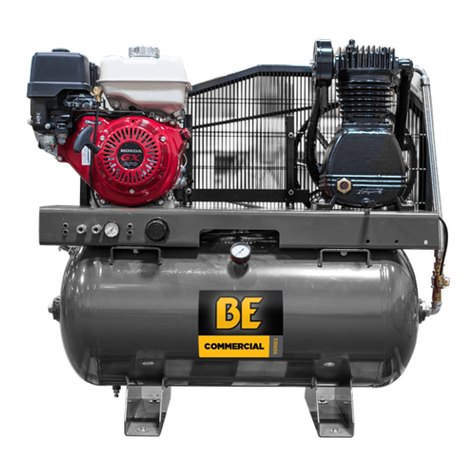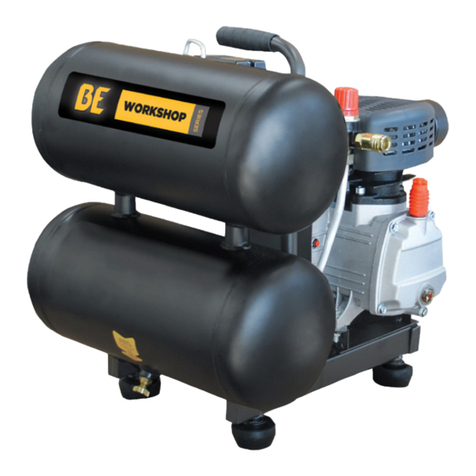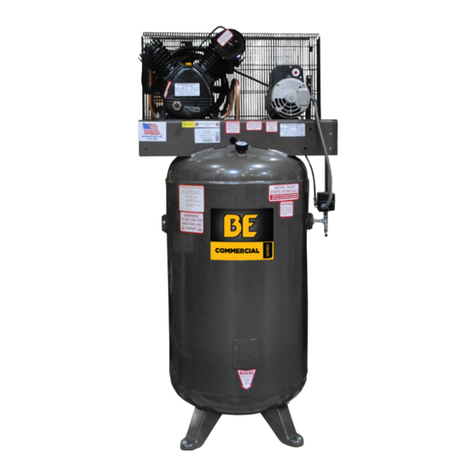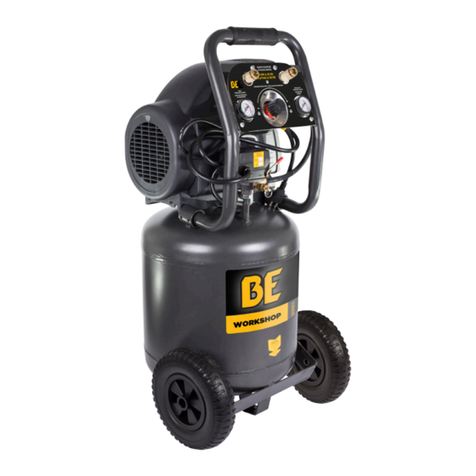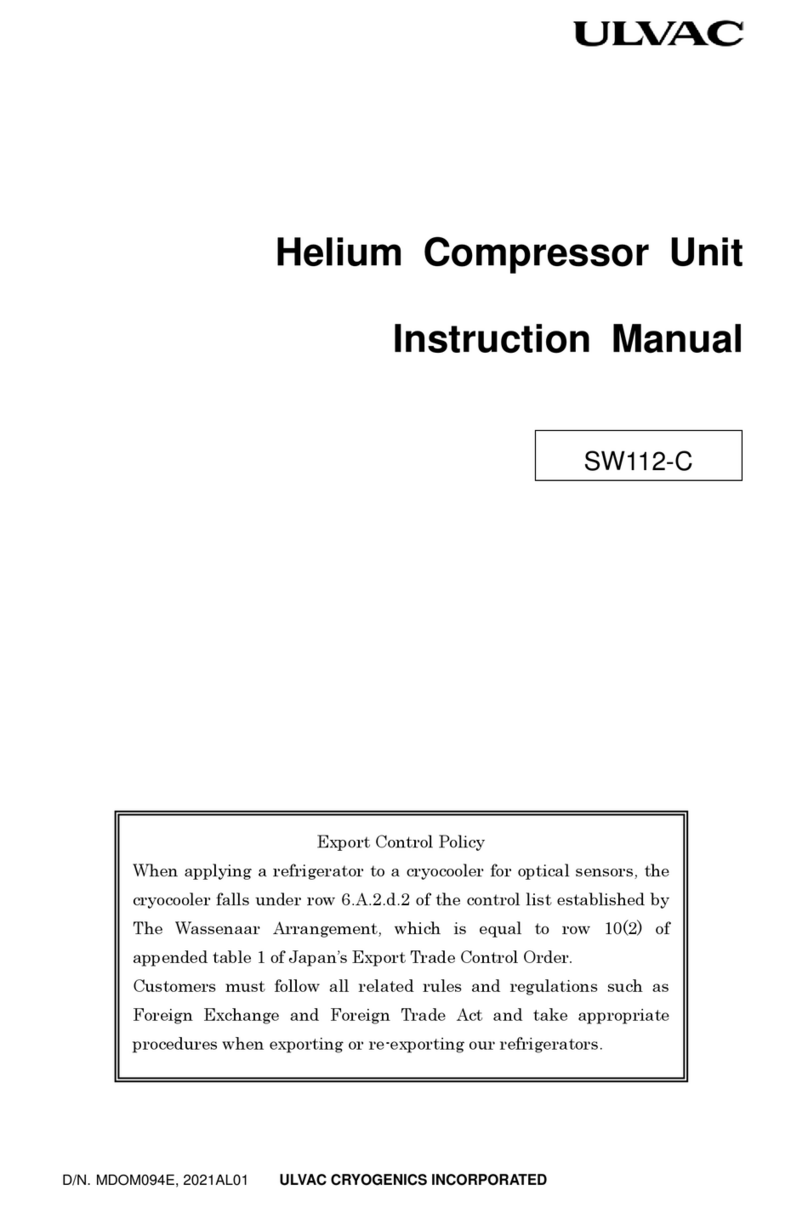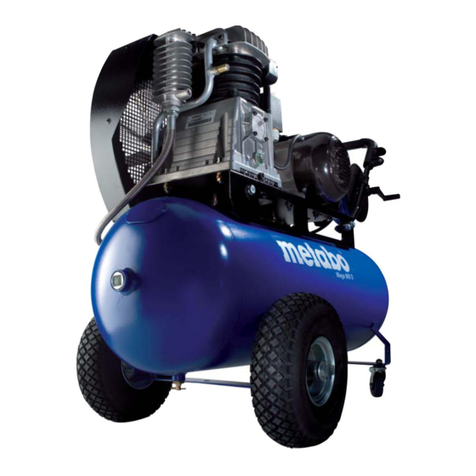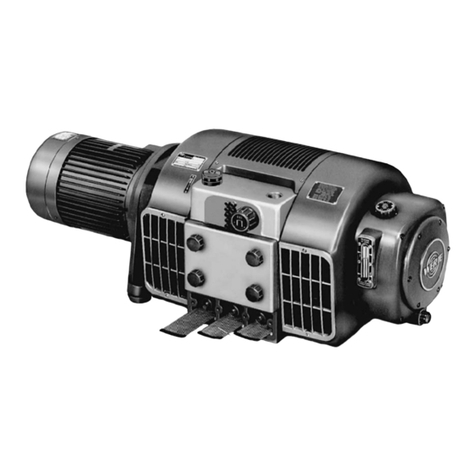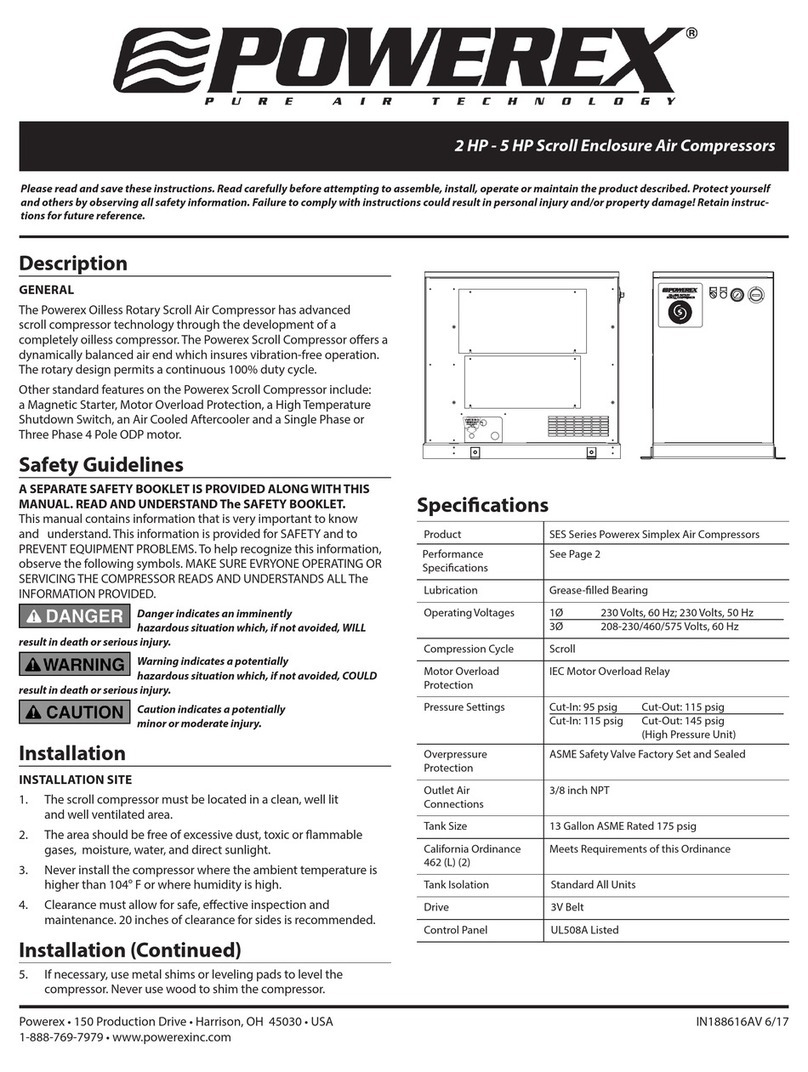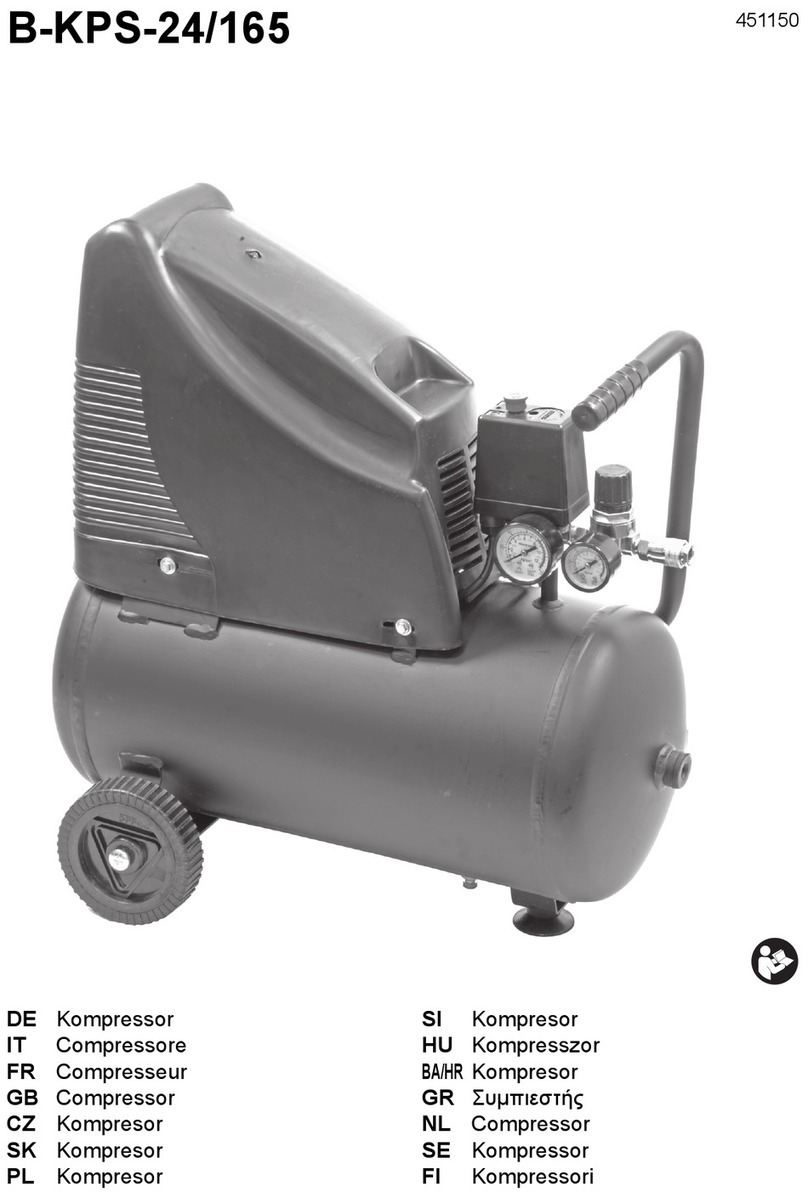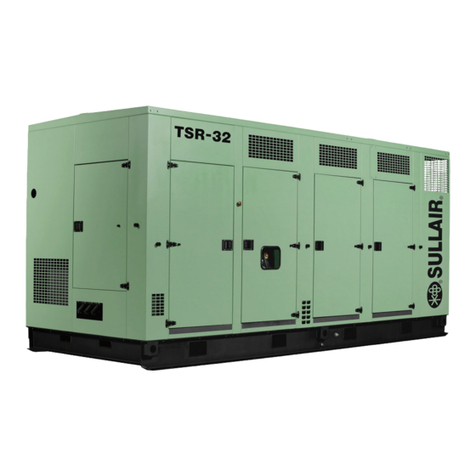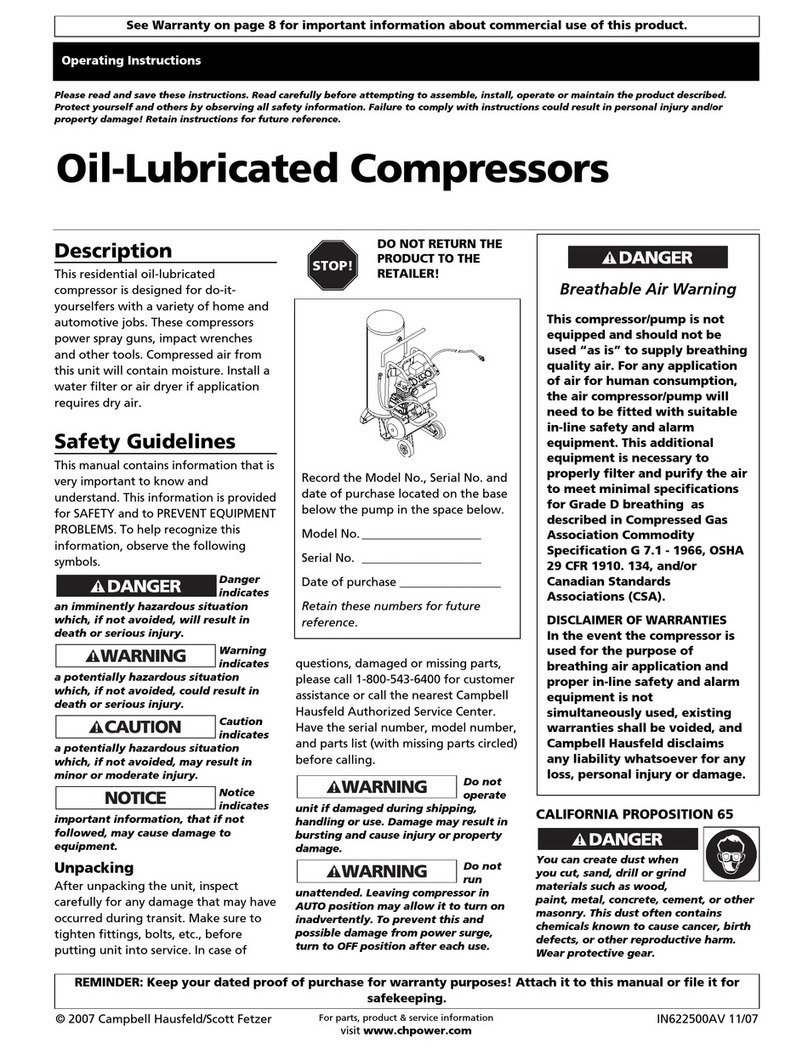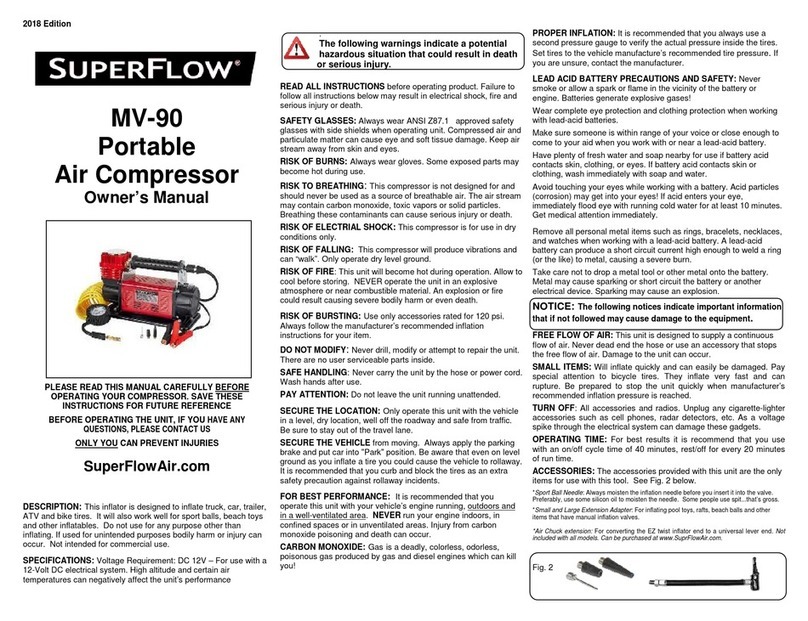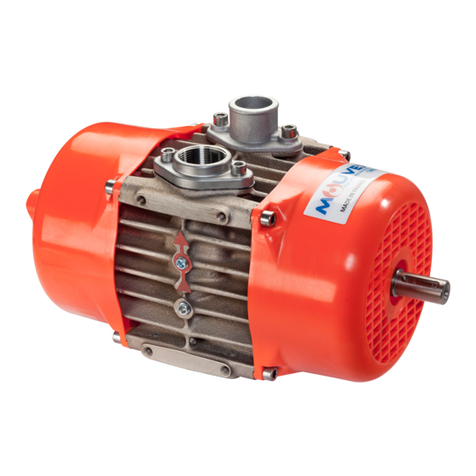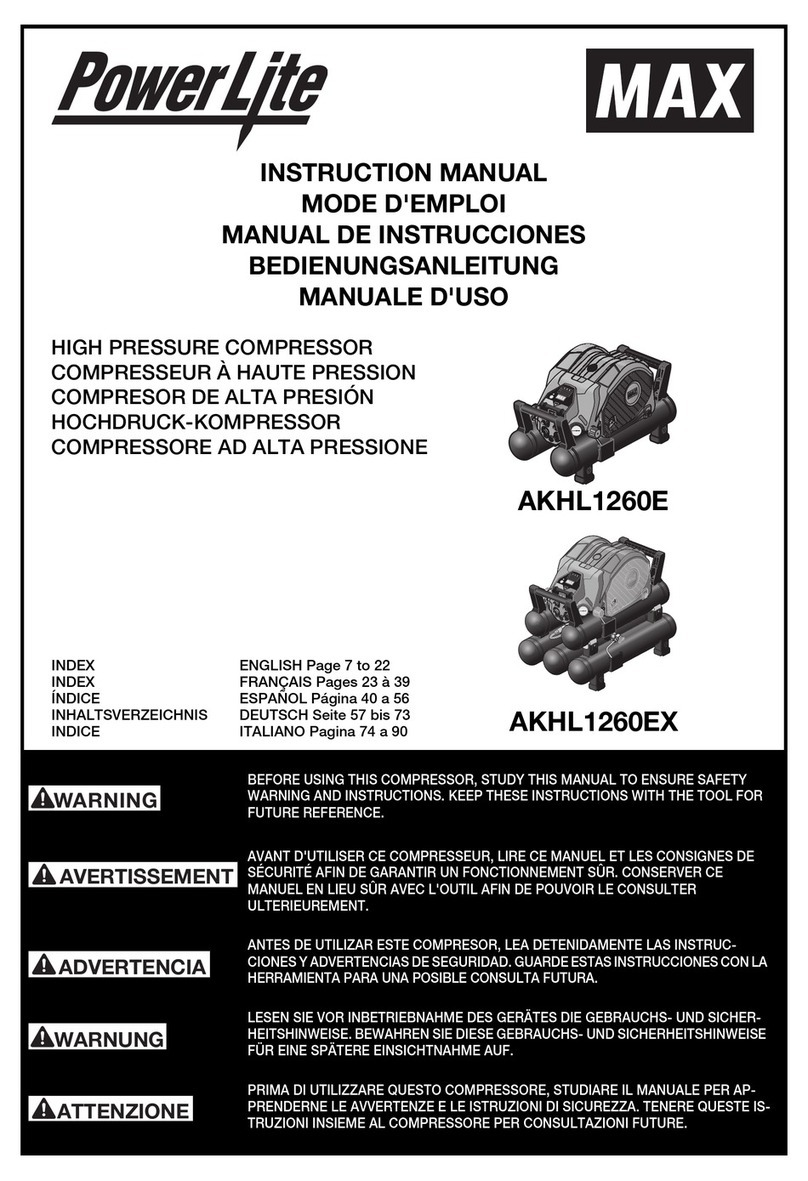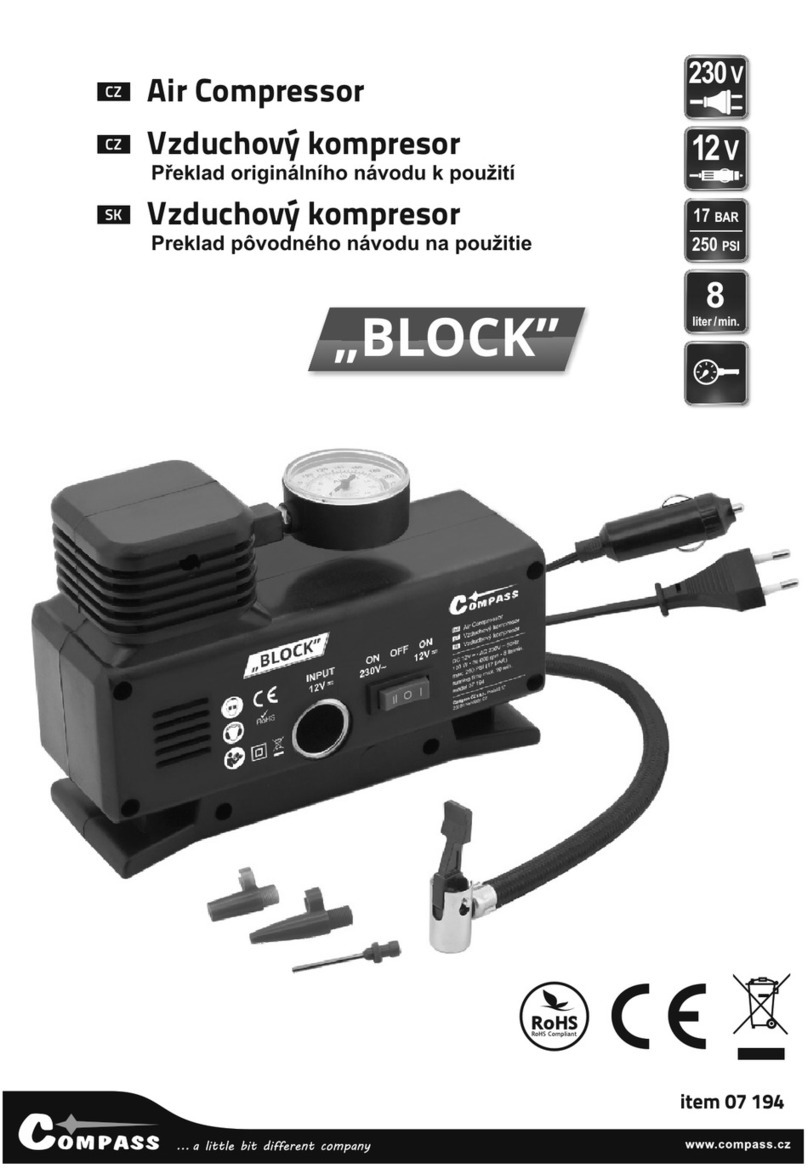BE AC658HB User manual

WHEELED AIR
COMPRESSOR
User Manual
AC658HB
AC708RB
AC908HB
AC908HB2
AC6520HB

2
table of contents
Introduction
4 Using the Operators Manual
Product Identification
5 Record Identification Numbers
Safety
6 Safety Instructions
7 Safety Rules
7 Hazard Symbols and Meanings
10 General Safety Information
Safety & Installation
11 Spraying Precautions
11 Hose Precautions
11 Installation and Location
11 Extension Cords
Assembly Instructions
12 Assembly
Product Features
13 Automatic ON/OFF
13 Regulator
13 Tank Pressure Gauge
13 Safety Valve
13 Tank Drain Fitting
13 Safety Guard

3
table of contents
Operating Instructions
14 Initial Start Up
14 Start Up
14 Storage
14 Shut Down
Maintenance
15 When performing maintenance or service
15 Daily
15 Weekly
15 Monthly
15 Six Months or 250 Operating Hours
15 Oil Change
Troubleshooting
16 Troubleshooting Chart
Parts
17 AC708RB/AC658HB/AC908HB Parts Diagram and List
18 AC6520HB Parts
20 AC908HB2 Diagram & Parts List
23 AC708RB/AC658HB/AC6520HB Pump & Parts List
24 AC908HB Pump & Parts List
26 AC908HB2 Pump & Parts List
Warranty
28 Warranty Statement

4
Using the Operator’s Manual
This manual gives information with respect to operation and
maintenance of the Compressor. Be sure to read it carefully first
before operation.
Following the manual can ensure the user’s safety and get the best
results from the compressor. All information and diagrams in this
manual are in accordance with the newest products at the publishing
time.
We strive for accuracy and this manual is accurate for the models
described at the time of printing. We reserve the right to make
improvements or changes at any time without notice or obligation.
Please keep this manual with the engine permanently, even if the
engine ownership is transferred.
Attention: Read through the complete
manual prior to the initial use of your
compressor.
introduction

5
product identification
Congratulations on your purchase of a BE Power Equipment air
compressor. You can be confident that this machine is constructed and
tested with optimum performance and quality in mind.
Reading this manual will help get you the best results for set-up,
operation, maintenance and avoid personal injury or damage to your
machine. By knowing how best to operate this machine, you will be
better positioned to show others who may also operate the unit.
All the information in this manual is based on the latest product
information available at the time of printing. BE Power Equipment
reserves the right to make changes at any time without notice or
incurring any obligation.
Owner/Operator Responsibility
The owner/operator must have a thorough understanding of the
operation, maintenance and dangers associated with using this machine.
It must be understood that it is ultimately up to the owner/operator to
safely use this machine as outlined in this manual.
This manual is considered a part of the machine and needs to be kept
in a safe location. If the machine is resold or given to someone else, this
manual needs to be included.
Product Registration
Please register your product online to get the maximum benefit
from your warranty. Use the QR code below or register online at:
bepowerequipment.com/product-registration
It is recommended that you record the product identification numbers
in this manual. These numbers are important to have on hand if you
need to contact technical support (1-866-850-6662). The model and
serial number can be found on the box and on decal on the machine.
PRODUCT IDENTIFICATION
Model Number:
Serial Number:
Date of Purchase:
Dealer Name:

6
safety
Safety Instructions
· Carefully read through the entire owners manual before operating
this compressor.
· Keep manual with important records for safety instructions, operat-
ing procedures and warranty.
· After unpacking your new air compressor, please inspect it carefully
for any damage that may have occurred during transit.
· Do not operate this air compressor if damaged during shipment,
handling or misuse.
· Damage may result in bursting, which can cause serious injury or
property damage.
· All damaged parts must be repaired or replaced as needed prior to
operating this air compressor.
· Check to see that all nuts, bolts and fittings are secure.
· Check to see that the proper lubrication oil, which has been included
with the air compressor, is used to fill the compressor crankcase to
the proper level.
· Please contact our customer service department at the numbers
listed on the back of this instruction manual for any questions or
comments regarding this air compressor.

7
The safety alert symbol ( ) is used with a signal word (DANGER,
CAUTION, WARNING), a pictorial and/or a safety message to alert
you to hazards.
DANGER indicates a hazard which, if not avoided, will result in
death or serious injury.
WARNING indicates a hazard which, if not avoided, could result in
death or serious injury.
CAUTION indicates a hazard which, if not avoided, might result in
minor or moderate injury.
NOTICE indicates a situation that could result in equipment dam-
age. Follow safety messages to avoid or reduce the risk of injury or
death.
HAZARD SYMBOLS AND MEANINGS
Save these Instructions
SAFETY RULES
safety
This is the safety alert symbol. It is used to alert
you to potential personal injury hazards. Obey
all safety messages that follow this symbol to
avoid possible injury or death.
explosion
kickback
fall fluid injection moving parts read manual
hot surface wear eye
protection
slippery
fire electric shock toxic fumes

8
safety
WARNING
AIR TANK WARNING: Drain liquid from air tank daily,
or after each use, using the drain valve located on
the bottom of the lower air tank. Failure to properly
drain liquid from the tank will cause rust from mois-
ture buildup, which weakens the tank and could lead
to a violent tank explosion, Periodically inspect the
tanks for unsafe conditions such as corrosion.
Never attempt to repair or make modifications to the tank or its at-
tachments. Welding, drilling or any other modifications may weaken
the tank, which may result in damage from rupture or explosion.
Never remove or attempt to adjust the pressure switch, safety
valve, or other factory set operating pressures.
WARNING
FIRE WARNING: Avoid dangerous environments. Do
not use compressor near gasoline or other flamma-
ble materials. Keep work area well lit. Normal spark-
ing of a motor or sparking from grinding metal could
ignite fumes. Do not spray flammable materials in the
vicinity of an open flame or other ignition source, in-
cluding the air compressor itself. Do not direct paint
or other spray material towards the compressor.
Read and follow all safely instructions for the material you are
spraying. Be sure to use an approved respirator designed for use
with your specific application.
WARNING
BREATHABLE AIR WARNING: This air compres-
sor in not designed, nor intended for the supply of
breathable quality air. Air produced by this unit may
contain carbon monoxide or other toxic vapors.
Do not inhale air from the compressor or from a breathing device
connected to it.

9
safety
WARNING
AIR TOOLS AND ACCESSORIES WARNING: Do not
exceed the pressure rating of any air tools, spray
guns, air accessories, or inflatables. Excess pressure
can cause them to explode, resulting in serious injury.
Follow the manufacturers recommended pressure
settings for all air tools and air accessories.
WARNING
Do not direct compressed air stream at people or
pets. The powerful compressed air stream can dam-
age exposed skin and easily propel loose dirt and
other small objects. Always wear eye protection that
meets ANSI Z28.1 specifications.
WARNING
Keep hands and fingers away from exposed metal
parts on a running air compressor. Air compressors
generate significant heat during normal operation,
which can cause serious burns. The compressor will
remain hot for some time after operation and should
not be touched or moved until cool.

10
safety
GENERAL SAFETY INFORMATION
Do not operate unit if damaged during shipping, handling or use.
Damage may result in bursting and cause injury or property damage.
Since the air compressor and other components (filters, lubricators,
hoses, etc.) used, make up a high pressure pumping system, the
following safety precautions must be observed at all times:
1. Read all manuals included with this product carefully. Be
thoroughly familiar with the controls and the proper use of the
equipment.
2. Follow all local electrical and safety codes
3. Only persons well acquainted with these rules of safe operation
should be allowed to use the compressor.
4. Keep visitors away and NEVER allow children in the work area.
5. Wear safety glasses and use hearing protection when operating
the pump or unit.
6. Do not stand on or use the pump or unit as a handhold.
7. Before each use, inspect compressed air system and electrical
components for signs of damage, deterioration, weakness or
leakage. Repair or replace defective items before using.
WARNING
Compressor parts may be hot even if the unit
is stopped. Wait for at least 5 minutes after
shutting the unit down before moving the unit.
8. Check all fasteners at frequent intervals for proper tightness.
9. Keep fingers away from a running compressor; fast moving and
hot parts will cause injury and/or burns.
10. If the equipment should start to abnormally vibrate, STOP the
engine/motor and check immediately for the cause. Vibration is
generally a warning of trouble.
11. To reduce fire hazard, keep engine/motor exterior free of
oil, solvent, or excessive grease. Never remove or attempt to
adjust safety valve. Keep safety valve free from paint and other
accumulations.
12. Never attempt to repair or modify a tank! Welding, drilling or any
other modification will weaken the tank resulting in damage from
rupture or explosion. Always replace worn or damaged tanks.
Drain liquid from tank daily.
13. Tanks rust from moisture build-up, which weakens the tank.
Make sure to drain tank daily and inspect periodically for unsafe
conditions such as rust formation and corrosion.

11
safety &installation
WARNING
Do not spray flammable materials in vicinity of open
flame or near ignition sources including the compres-
sor unit.
14. Fast moving air will stir up dust and debris which may be harmful.
Release air slowly when draining moisture or depressurizing the
compressor system.
SPRAYING PRECAUTIONS
15. Do not smoke when spraying paint, insecticides, or other
flammable substances.
16. Use a face mask/respirator when spraying and spray in a well
ventilated area to prevent health and fire hazards.
17. Do not direct paint or other sprayed material at the compressor.
Locate compressor as far away from the spraying area as possible
to minimize overspray accumulation on the compressor.
18. When spraying or cleaning with solvents or toxic chemicals, follow
the instructions provided by the chemical manufacturer.
HOSE PRECAUTIONS
19. Inspect hose before use. Do not exceed working pressure marked
on hose. Do not twist, bend knot, or abrade hose. Do not wrap
hose around body.
20. Keep away from hot surfaces and chemicals.
Installation
INSTALLATION AND LOCATION
The compressor must be used on a stable level surface. The air
compressor must be used in a clean and well-ventilated area.
The compressor requires an unobstructed airflow and must be
located a minimum of 18 inches from any walls or other ob-
structions.
Extension Cord Length Wire Size (A.W.C.)
Up to 25 Feet 14
26 to 50 Feet 12
51 to 100 Feet 10

12
assembly instructions
WARNING
The compressor is shipped without oil in the crank-
case. Add oil as indicated below.
Assembly
Read all safety instructions before using air compressor.
1. After opening the carton, please remove all parts and check against
photograph on carton. If any parts are missing, please call 1-800-663-
8331.
2. Place air compressor on a flat, level surface.
3. Pour supplied oil into crankcase until the oil level reaches the red dot
in the oil level sight glass. Be careful not to overfill.
Refill Oil
Immediately
Check Oil
Level Daily
Oil Level OK
NOTICE
Do not operate the compressor without lubricant or with low
lubricant level. We are not responsible for damage caused to the
compressor due to operation without proper lubrication.
4. Adjust tension of belt to ensure that a maximum of 1/2” / 12mm of
slack exists when pressure is placed on belt at centre line.
5. NOTE: If the belt is installed too tightly, overloading of the motor will
occur. This will cause the motor to overheat. If the belt is installed
too loosely, it will slip and unstable operation and vibration will oc-
cur. Caution - The rotating direction for the flywheel must follow the
arrow shown on the belt guard.
6. Close tank drain valve on the bottom of the air tank by turning the
valve clockwise until fully closed.
7. Attach the air coupler to the compressor regulator valve. Use Teflon
thread-sealing tape on the threads to make sure you have an airtight
connection. Do not over tighten fittings.
8. Attach the supplied air filter to the air intake port on the pump head.
9. Attach air hose and any desired air accessories (which are not in-
cluded). Use Teflon thread-sealing tape on the threads to make sure
you have an airtight connection. Do not over-tighten fittings.
1/2”

13
Product Features
1. Automatic ON/OFF Pressure Switch
The compressor is equipped with an automatic on/o pressure
switch. The compressor will only run when the switch is in the
“I”(ON) position. Once the tank has reached the desired preset
pressure (see Operation Instructions), the pump will automatically
shut o. While the switch is in the “I”(ON) position, the pump will
automatically turn back on once the pressure in the tank drops
below the minimum preset pressure. Do not leave the compressor
unattended while the power switch is in the “I”(ON) position.
2. Regulator
The regulator allows you to select the amount of air pressure that
is output through the air hose into tools and accessories. Refer to
the air delivery requirements of your tools for the proper pressure
settings.
3. Tank Pressure Gauge
The tank pressure gauge provides a reading of the air pressure
inside of the compressor tank.
4. Safety Valve
This compressor is equipped with a safely valve switch that will
engage when the pressure in the tank exceeds the maximum rated
pressure. DO NOT attempt to modify or remove safely valve.
5. Tank Drain Fitting
Water is produced whenever air is compressed. It is critical to drain
water from the air tank on this compressor frequently. If unit is used
only occasionally, tank should be drained after each use and prior
to the next use. To drain the tank, slowly open the tank drain fitting
by turning clockwise. Once all water has drained out, close the fit-
ting securely. NOTE: tank will not pressurize while fitting is open.
6. Safety Guard
The belt drive mechanism is protected by a metal guard. Do not
attempt to modify or remove this safety guard.
product features

14
operation
Operating Instructions
Initial Start Up
1. Disconnect tools and/or accessories from the air hose.
2. Open the tank drain valve to allow air to escape preventing air pressure
buildup in the air tank.
3. Check to see that the belt is installed properly with the correct tension.
4. Plug power supply cord into proper power source receptacle. (See
Grounding Instructions)
5. Run the compressor for a minimum or twenty minutes in this no-load
position to lubricate the bearings and piston.
6. Turn o compressor, drain liquid from tanks and close drain valve.
7. The compressor is now ready for use.
Start Up
1. Slowly open tank drain by turning clockwise. Allow any water in tank to
drain out. Close fitting securely.
2. Before starting the compressor, check for broken components and
accessories, and check for damage to the hose.
3. Make sure the power switch is turned “O”(OFF) position.
4. Attach desired tool to the end of the air hose.
5. Turn the switch on the “I”(ON) position.
6. Adjust regulator knob to desired pressure level once the pump has shut
o and the compressor has stopped running.
Storage
1. Disconnect tools and/or accessories from the air hose.
2. Locate drain valve on bottom side of tank.
3. Open drain valve to release remaining pressurized air and moisture
from the air tank. Moisture buildup in the tank is normal with air
compressors, so a small amount of water may come out while draining
the tank. Draining the tank is vital for longevity and safety of your air
compressor.
4. Close valve and store the compressor in a cool, dry place.
Shut Down
1. Turn the ON/OFF lever to the OFF position.
2. Rotate the pressure regulator knob counterclockwise until it is fully
closed. Check regulated pressure gauge to ensure that it reads 0 PSI.
3. Remove air hose and other connected accessories.
4. Slowly open air tank drain valve to release remaining pressurized air,
and tilt unit to fully drain accumulated liquid from air tanks. Moisture
build-up in the tank is normal with air compressor, so a small amount of
water may come out while draining the tank. Draining the tank is vital
for the longevity and safely of your air compressor.
5. Close drain valve.
6. Allow compressor to cool down.
7. Clean and store compressor.

15
maintenance
Maintenance
When performing any maintenance or service
· The air compressor must be turned o.
· Drain tanks.
· Allow compressor to cool down.
Daily
· Check oil level.
· Drain accumulated liquid from tanks.
· Check for oil leaks.
· Check for unusual noise and/or vibrations
· Check that all fasteners are secure.
Weekly
· Check safety relief valve.
· Inspect and clean air filter.
· Clean breather holes on oil check dipstick.
Monthly
· Check for air leaks.
· Apply a solution of soapy water around joints.
· Look for air bubbles around joints when compressor reaches the
pressure cut-out limit and pump turns o.
· Adjust belt tension and replace if worn or damaged.
Six Months or 250 Operating Hours
· Change compressor oil.
· Use only SAE 20 or SAE 30 weight non-detergent oil.
· Replace oil more frequently when used in dusty operating environ-
ments.
Oil Change
1. Place oil drain pan below oil drain plug.
2. Remove dipstick to allow air to enter crankcase.
3. Remove oil drain plug.
4. Allow oil to drain completely.
5. Clean and replace oil drain plug.
6. Refill crankcase with SAE 20 or SAE 30 weight non-detergent oil to
red dot on oil level sight glass. Be careful not to overfill.

16
troubleshooting
Trouble Possible Cause Corrective Action
No start
condition
Gas engine not running Check operation of gas
engine and ensure that
the fuel valve is open.
Low pressure Air leak in safety valve Check valve manually by
pulling upward on rings.
If condition persists,
replace valve.
Loose tube or fittings Tighten fittings
Restricted air filter Clean or replace
Belt loose Adjust belt tension
Defective check valve Replace check valve
Safety valve re-
leasing
Defective pressure
switch
or improper adjustment
Check for proper
adjustment and if
problem persists, replace
pressure switch
Oil discharge in
air
Improper oil viscosity Replace oil with 20-30
weight non-detergent oil
Too much oil in
crankcase
Drain crankcase and fill
to proper level
Restricted air filter Clean or replace filter
Worn piston rings Replace piston rings
Excessive belt
wear
Belt too loose Adjust for proper tension
Belt too tight Adjust for proper tension
Motor pulley out of
alignment
Align motor pulley by
adjusting the position of
the electric motor
During the break-in period, nuts and bolts have a tendency to loosen.
After two weeks, tighten all nuts and bolts including head bolts.
Check every month to make sure all nuts and bolts stay tight.
Troubleshooting Chart

17
Parts List
No. Description Qty
1 Exhaust Pipe Assembly 1
2 Safety Guard 1
3Safety Guard 1
4Bolt 2
5Spring Washer 2
6Washer 2
7M5x0.8x8 Screw 3
8V-Belt 1
9Engine 1
10 In-six Angle Bolt 1
11 Motor Pulley 1
12 Bolt 4
13 Spring Washer 4
14 Six Angle Nut 4
15 Pump 1
16 Bolt 4
17 Spring Washer 4
18 Six Angle Nut 4
19 Discharge tubing 1
20 Six Angle Nut 1
21 Grip, Handle 2
22 Manifold 1
23 Pressure Gauge 2
No. Description Qty
24 Quick Disconnect 2
25 Safety valve 1
26 Screw,Cross recess head 2
27 nipple 2
28 Pipe 1
29 Drain Cock 2
30 Foot Rubber Pad 4
31 8 Flat Washer 4
32 Spring Washer 4
33 Bolt 4
34 Pilot Unloader Valve 1
35 Gas Pedal 1
36 Exhaust Elbow 1
37 Air Tank 1
38 Tank Wheel 1
39 Screw,Cross recess head 2
40 Spring Washer 2
41 Six Angle Nut 2
42 Washer 2
43 Screw 1
44 Six Angle Nut 1
45 link span 1
Parts Diagram
AC708RB/AC658HB/AC908HB
parts

18
AC6520HB Parts
parts

19
AC6520HB Parts
No. Description Q'ty
1 Safety Guard 1
2 Safety Guard 1
3 Bolt 2
4 Spring Washer 2
5 Washer 2
6 M5x0.8x8 Screw 3
7 V-Belt 1
8 Engine 1
9 In-six Angle Bolt 1
10 Motor Pulley 1
11 Bolt 4
12 Spring Washer 4
13 Six Angle Nut 4
14 Pump 1
15 Bolt 4
16 Spring Washer 4
17 Six Angle Nut 4
18 Discharge tubing 1
19 Six Angle Nut 1
20 Safety valve 1
21 Pressure Gauge 2
22 Manifold 1
23 nipple 2
24 Regulator 1
25 Quick Disconnect 2
26 Foot Rubber Pad 2
27 6 Flat Washer 2
28 Spring Washer 2
29 Six Angle Nut 2
30 Drain Cock 1
31 Air Tank 1
32 Bolt 2
33 Tank Wheel 2
34 Six Angle Nut 2
35 Pilot Unloader Valve 1
36 Gas Pedal 1
37 Exhaust Elbow 1
38 Exhaust Pipe Assembly 1
39 link span 1
40 Washer 1
41 Screw 1
42 Six Angle Nut 1
parts

20
20
13
14
16
AC908HB2 Parts
parts
This manual suits for next models
4
Table of contents
Other BE Air Compressor manuals
Popular Air Compressor manuals by other brands

Strend Pro
Strend Pro BOF1506 instruction manual
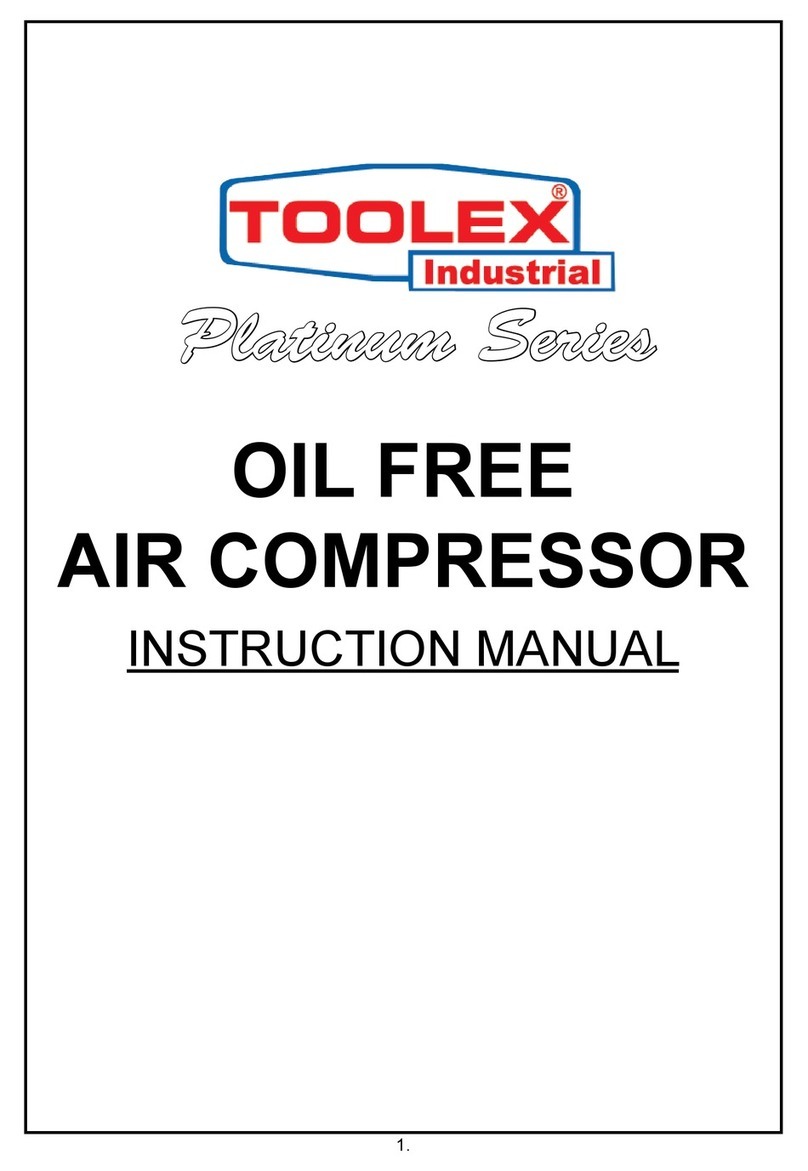
Toolex
Toolex Platinum Series instruction manual
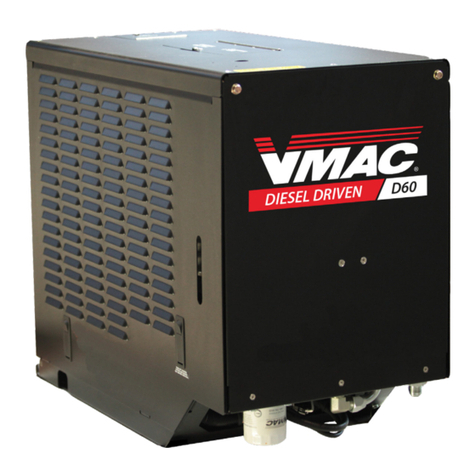
Vmac
Vmac D600003 Installation and owner's manual
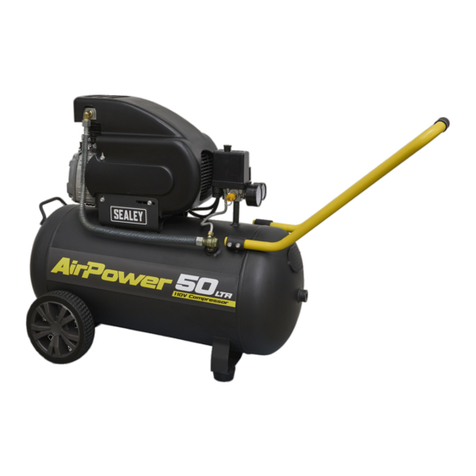
Sealey
Sealey sac5020e110v.v3 manual
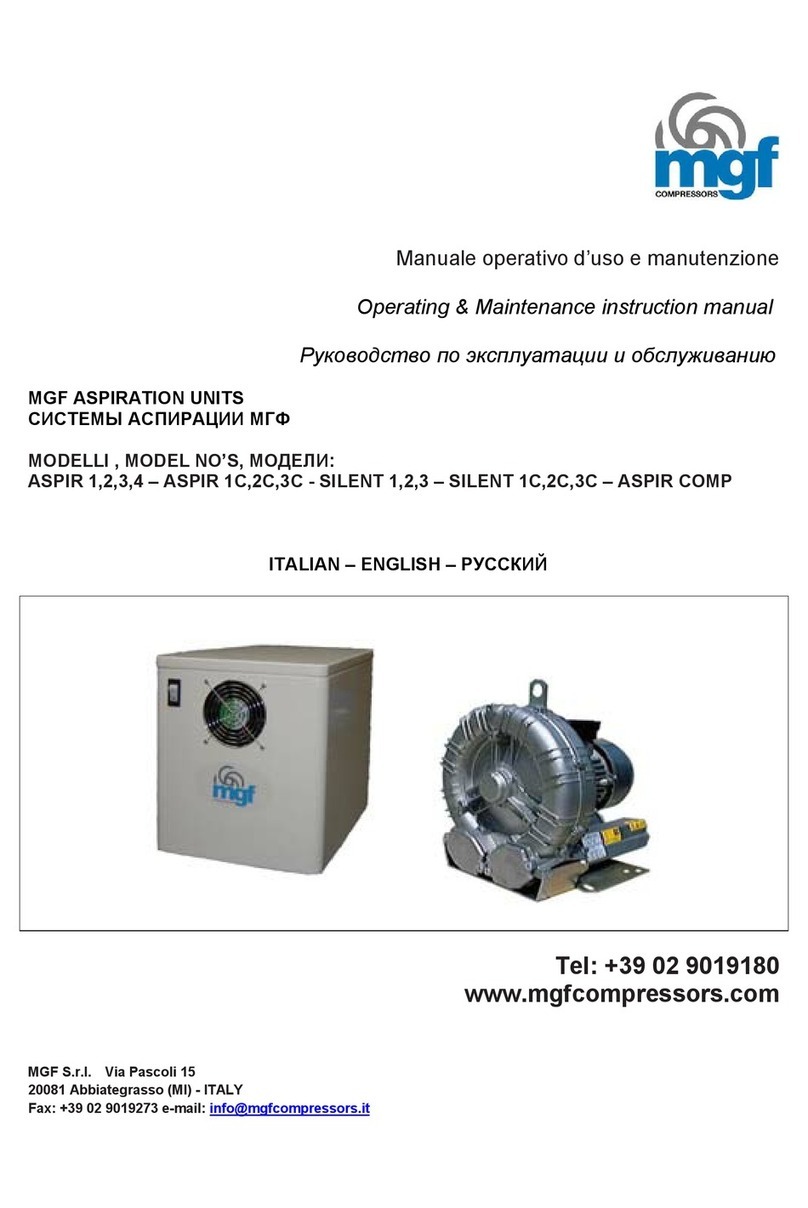
MGF
MGF ASPIR 1 Operating & maintenance instruction manual
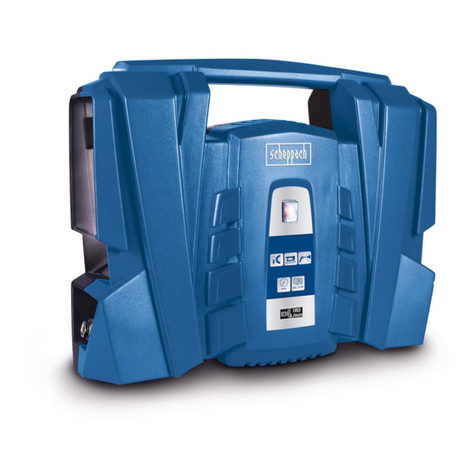
Scheppach
Scheppach Air Force 4 Translation from the original instruction manual
